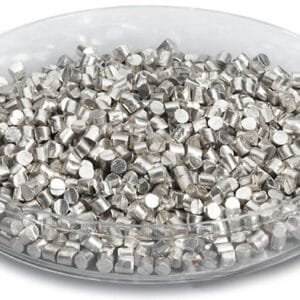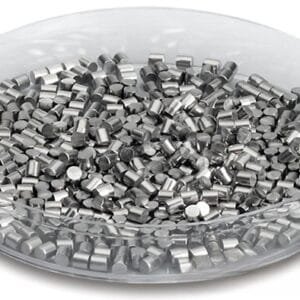Scandium(III) Oxide Evaporation Materials Overview
Thin-Film Mat Engineering (TFM) offers premium scandium(III) oxide evaporation materials, identified by the chemical formula Sc₂O₃. These high-purity materials are crucial for achieving superior quality in deposition processes. With TFM’s commitment to excellence, our scandium(III) oxide boasts purity levels up to 99.9995%, supported by comprehensive quality assurance.
Features of Scandium Oxide (Sc₂O₃)
- Crystal Structure: Cubic
- Band Gap: 6.0 eV (insulator)
Scandium(III) Oxide Evaporation Materials Specification
| Material Type | Scandium(III) oxide |
| Symbol | Sc2O3 |
| Color/Appearance | White Solid |
| Melting Point | 2,485 °C |
| Theoretical Density | 3.86 g/cm3 |
| Purity | 99.9% ~ 99.99% |
| Shape | Powder/ Pellets/ Granule/ Custom-made |
Available Types
| Item No. | Description | Purity (Sc2O3/TREO) | Lot Size |
| OX21-4N | Scandium Oxide D50 = 2 ~ 5 µm | 99.99% | 500g, 1000g, 2000g, 5000g |
| OX21VD-4N | Scandium Oxide for vacuum deposition. | 99.99% 3-12mm or custom size | 100g, 250g, 1000g |
| OX21-5N | Scandium Oxide D50 = 2 ~ 5 µm | 99.999% | 500g, 1000g, 2000g, 5000g |
| OX21-5N5 | Scandium Oxide D50 = 2 ~ 5 µm | 99.9995% | 100g, 500g, 1000g |
Applications
Scandium(III) oxide (Sc₂O₃), or Scandia, is employed in:
- High-Intensity Lighting: Production of stadium lights.
- Scandium Compounds: Preparation of other scandium compounds and high-temperature systems, known for heat and thermal shock resistance.
- Electronics: Used in electronic ceramics and glass composition.
- Deposition Processes: Ideal for semiconductor deposition, chemical vapor deposition (CVD), and physical vapor deposition (PVD).
- Optics: Scandia thin-films are used for wear protection, decorative coatings, and displays.
Packaging and Handling
Our scandium(III) oxide materials are carefully tagged and labeled to ensure proper identification and quality control. We ensure that all products are protected from damage during storage and transport.
Contact Us
For high-purity scandium(III) oxide in various forms—including tablets, granules, rods, and wires—or for custom requirements, contact Thin-Film Mat Engineering (TFM). We also supply evaporation sources, boats, filaments, crucibles, heaters, and e-beam crucible liners. Reach out to us for current pricing and details on materials not listed.


 MSDS File
MSDS File



Reviews
There are no reviews yet.